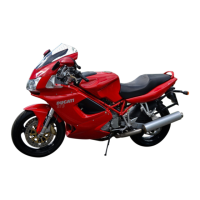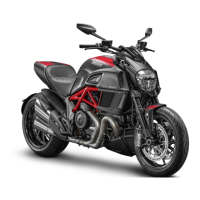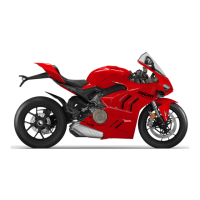Do you have a question about the Ducati 250 Mark 3 1965 and is the answer not in the manual?
Information required for ordering spare parts, including serial numbers and catalogue codes.
Technical specifications of the engine, including bore, stroke, capacity, and compression ratio.
Details on valve timing, clearance, and diagrams for different models.
Information on how fuel is supplied to the carburetor and carburetor specifications.
Explanation of the engine's pressure lubrication system and oil capacity.
Explanation of the centrifugal oil filter's operation and oil flow.
Description of the engine's cooling system through finning.
Procedure for checking and adjusting ignition spark advance.
Instructions for starting the motorcycle using the kick-starter.
Details on the clutch, gearbox, and gear ratios.
Description of the motorcycle's frame construction.
Details on the front and rear suspension systems.
Information on the expanding type brakes and drum diameters.
Overview of the motorcycle's electrical system and its components.
Summary of the advantages offered by the new electrical system.
Explanation of the wiring system's operation based on key insertion and commutator positions.
Details on electrical systems for Mark III and Scrambler models, including generator.
Schematic diagram of the electrical system for Mark III and Scrambler models.
Description of handlebar and foot controls for operation.
Information on the types of saddles provided for different models.
Fuel consumption and maximum cruising distance for GT and Monza models.
Fuel consumption and maximum cruising distance for Mach 1 and Mark III models.
Fuel consumption and maximum cruising distance for the Scrambler model.
Instructions for filling the fuel tank and starting the engine.
Guidance on starting off, changing gears, and riding the motorcycle.
Procedures for stopping the motorcycle and its engine safely.
Recommended maintenance tasks to be performed every 500 km.
Recommended maintenance tasks to be performed every 1000 km.
Recommended maintenance tasks to be performed every 2000 km.
Recommended maintenance tasks for high mileage intervals.
Instructions for overall cleaning and headlamp alignment.
Recommendations for storing the motorcycle for extended periods.
Information on the electrolyte composition and density requirements.
Detailed steps for initial and successive battery charging.
List and description of specialized tools for service stations.
Legend identifying each tool in the tool equipment list.
Troubleshooting steps for when the engine fails to start easily.
Troubleshooting steps for an engine that is not running efficiently.
Information required for ordering spare parts, including serial numbers and catalogue codes.
Technical specifications of the engine, including bore, stroke, capacity, and compression ratio.
Details on valve timing, clearance, and diagrams for different models.
Information on how fuel is supplied to the carburetor and carburetor specifications.
Explanation of the engine's pressure lubrication system and oil capacity.
Explanation of the centrifugal oil filter's operation and oil flow.
Description of the engine's cooling system through finning.
Procedure for checking and adjusting ignition spark advance.
Instructions for starting the motorcycle using the kick-starter.
Details on the clutch, gearbox, and gear ratios.
Description of the motorcycle's frame construction.
Details on the front and rear suspension systems.
Information on the expanding type brakes and drum diameters.
Overview of the motorcycle's electrical system and its components.
Summary of the advantages offered by the new electrical system.
Explanation of the wiring system's operation based on key insertion and commutator positions.
Details on electrical systems for Mark III and Scrambler models, including generator.
Schematic diagram of the electrical system for Mark III and Scrambler models.
Description of handlebar and foot controls for operation.
Information on the types of saddles provided for different models.
Fuel consumption and maximum cruising distance for GT and Monza models.
Fuel consumption and maximum cruising distance for Mach 1 and Mark III models.
Fuel consumption and maximum cruising distance for the Scrambler model.
Instructions for filling the fuel tank and starting the engine.
Guidance on starting off, changing gears, and riding the motorcycle.
Procedures for stopping the motorcycle and its engine safely.
Recommended maintenance tasks to be performed every 500 km.
Recommended maintenance tasks to be performed every 1000 km.
Recommended maintenance tasks to be performed every 2000 km.
Recommended maintenance tasks for high mileage intervals.
Instructions for overall cleaning and headlamp alignment.
Recommendations for storing the motorcycle for extended periods.
Information on the electrolyte composition and density requirements.
Detailed steps for initial and successive battery charging.
List and description of specialized tools for service stations.
Legend identifying each tool in the tool equipment list.
Troubleshooting steps for when the engine fails to start easily.
Troubleshooting steps for an engine that is not running efficiently.
| Brand | Ducati |
|---|---|
| Model | 250 Mark 3 1965 |
| Category | Motorcycle |
| Language | English |












